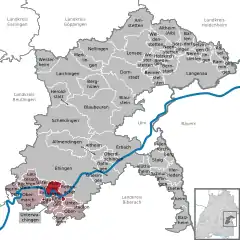Munderkingen
Munderkingen (![]() pronunciation ) is the smallest town in the district of Alb-Donau in Baden-Württemberg in Germany. It is situated on the Danube, 9 km southwest of Ehingen, and 31 km southwest of Ulm.
pronunciation ) is the smallest town in the district of Alb-Donau in Baden-Württemberg in Germany. It is situated on the Danube, 9 km southwest of Ehingen, and 31 km southwest of Ulm.
Munderkingen | |
|---|---|
 Munderkingen on the Danube river | |
 Coat of arms | |
Location of Munderkingen within Alb-Donau-Kreis district  | |
 Munderkingen  Munderkingen | |
| Coordinates: 48°14′7″N 9°38′38″E | |
| Country | Germany |
| State | Baden-Württemberg |
| Admin. region | Tübingen |
| District | Alb-Donau-Kreis |
| Government | |
| • Mayor | Michael Lohner |
| Area | |
| • Total | 13.08 km2 (5.05 sq mi) |
| Elevation | 516 m (1,693 ft) |
| Population (2019-12-31)[1] | |
| • Total | 5,384 |
| • Density | 410/km2 (1,100/sq mi) |
| Time zone | UTC+01:00 (CET) |
| • Summer (DST) | UTC+02:00 (CEST) |
| Postal codes | 89597 |
| Dialling codes | 07393 |
| Vehicle registration | UL |
| Website | www.munderkingen.de |
Buildings
Danube Bridge
The so-called "New Danube Bridge" 1893 was the first massive concrete arch bridge, which was built with an arch span of more than 50 m: Engineer Karl Leibbrand from Stuttgart was the builder, the work was carried out by the construction company Buck from Ehingen.[2][3] The bridge was busted in World War II, on April 22, 1945, by retreating German engineering troops. Reconstruction began immediately after the war. In June 1948, the re-created Danube bridge was inaugurated by the occupying power of the French zone.
Old hospital
Built in 1889–90, the historicist building belongs to the townscape.
Transport
Munderkingen is served by the Ulm–Sigmaringen railway.



Daughters and sons of the town
- Thomas Sattelberger (born 1949), German manager and politician (FDP)
- Thomas Locher (born 1956), artist
- Meinrad Kneer (born 1970), jazz musician
References
- "Bevölkerung nach Nationalität und Geschlecht am 31. Dezember 2019". Statistisches Landesamt Baden-Württemberg (in German). September 2020.
- Munderkinger Donaubrücke at Structurae. Retrieved de.
- Betonbrücken at Zeno.org. Article by: Viktor von Röll (ed.): Enzyklopädie des Eisenbahnwesens (Encyclopaedia of the Railway), 2nd edition, 1912–1923, Vol. 2, S. 271 ff. (Mit Darstellung des Längsschnittes und Gelenks der Donaubrücke)